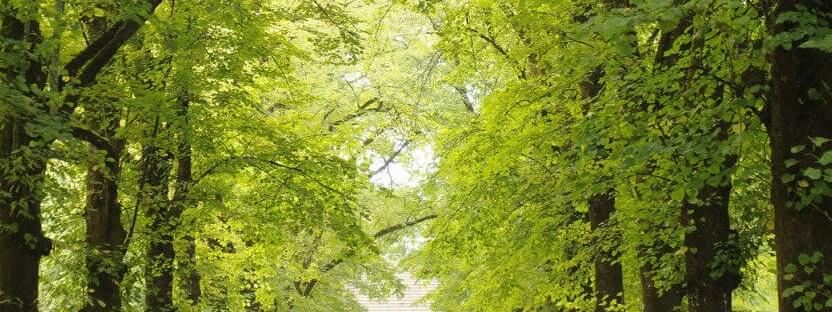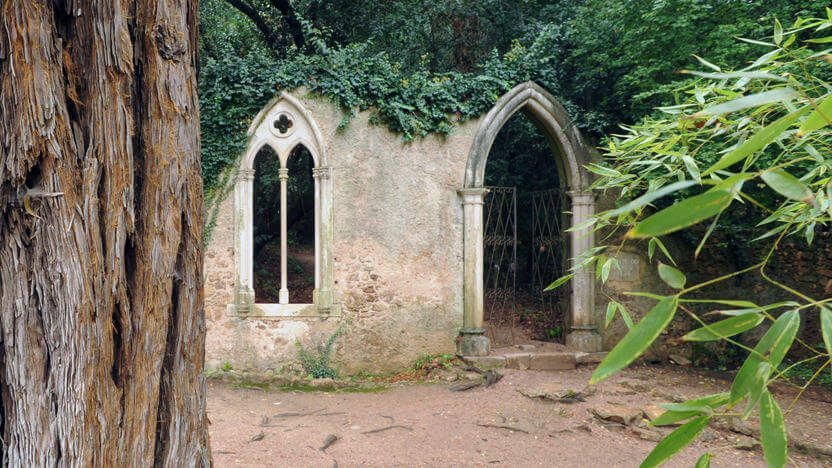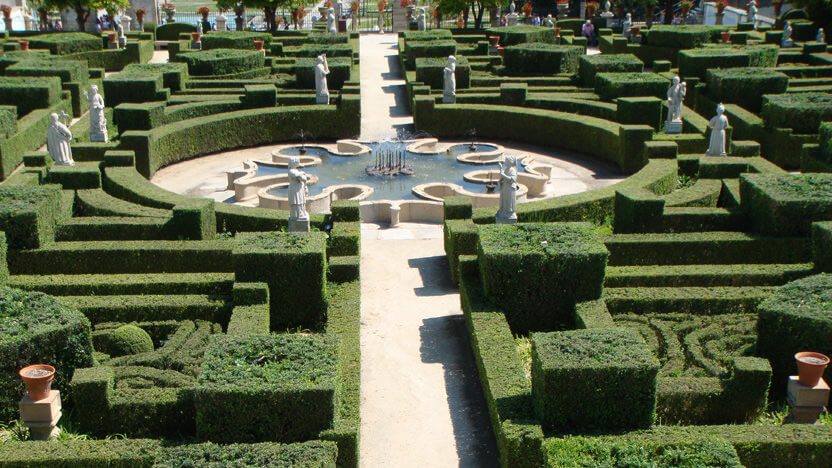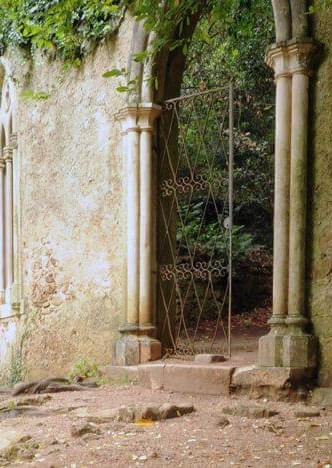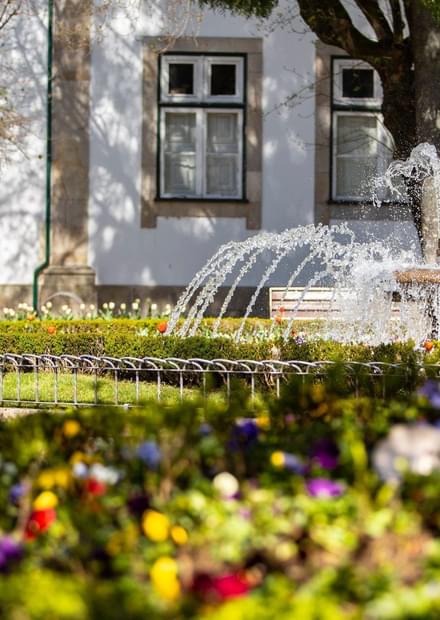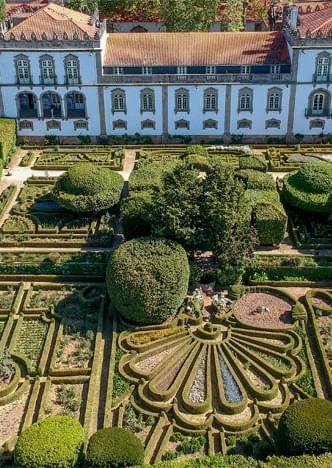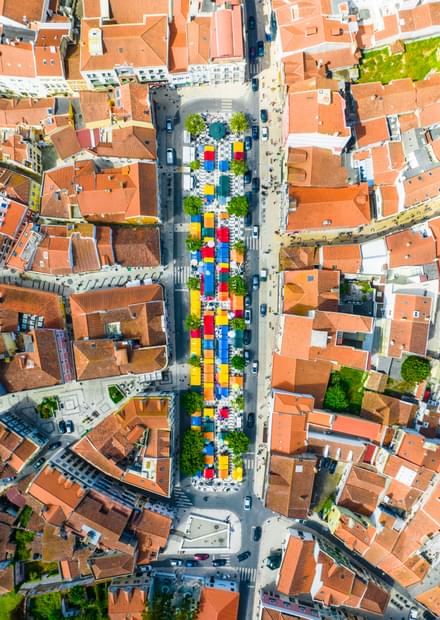Coimbra
The Gardens of Quinta das Lágrimas
Created to become a true herbal museum, the gardens at Quinta das Lágrimas gather species from all over the world. Their designer, Miguel Osório Cabral de Castro, took the advantage of being a friend of the Coimbra University Botanical Garden director to provide more variety to this outside space which became one of the most important places at Quinta das Lágrimas.
There is a wood area – which was once used by the royal family – and a garden area near the palace. The area has great sequoias, Judas trees, Chinese fan palms, Buçaco white cedars and Himalayan cedars, a Moreton Bay Fig and even a majestic Kusamaki, which comes from Southern Africa and there’s only one more in Portugal.
Botanical Garden of the University of Coimbra
The Botanical Garden occupied a considerable portion of the grounds of the College of São Bento, which had been given over to the University of Coimbra, undergoing extensive remodeling dating from the time of the Pombaline Reforms (1774). In 1854, the engineer Pezerat presented his project for a greenhouse (which is still in existence), marking a technological advance in the use of iron and glass in architecture in Coimbra. This building was completed in 1865. The works, carried out between 1944 and 1949, involved the addition of a fountain in the central square, stone benches, a cold greenhouse and the renovation of the thoroughfares between the various sections of the garden and the woodland area.
The survival of some of the buildings of the former Benedictine College, such as the old chapel in the woods, endows the place with a romantic historical air.In addition to the Botanical Garden’s various works of architecture and sculpture, there is an extensive biological heritage, involving thousands of ancient plant species. The Botanical Garden seems to be the perfect island in the centre of the city, but it is its scientific value that makes it unique.
Buçaco
Buçaco Woods
At the far end of Buçaco Mountain, where the highest range is 547 meters high, you’ll find Buçaco Woods, surrounded by a high wall with eleven entrance doors. Make them your starting point for a stroll through Nature in the region and fall in love with the serene exuberance, almost magical, of Buçaco’s intense green colour. After you track all paths in the mountain, take a rest at Bussaco Palace Hotel, one of the most beautiful neo-Manueline buildings in Portugal, or visit the Santa Cruz Convent, where General Wellington spent the night during the Battle of Buçaco. Indulge yourself in the charm of the flora and History of this place.
Buçaco Woods are very small when compared with other large European woods. However, the variety of its plant species is larger than in other wood. Within the walls built by the Carmelites, there are about 400 native species of the Portuguese Atlantic coast and around 300 which come from other climates. The most representative element of this symbiosis is the Buçaco cedar, an important cypress which comes from Mexico and might have been the first exotic species to be planted in the forest by the monks in 1656. The Saint Joseph Cedar, planted 350 years ago by the monks next to the door with the same name, is the local symbol of this majestic species of trees.
Viseu
Aquilino Ribeiro Municipal Park
Near Rossio lies a wide green spot stretching over a slight hill in a closed space located at the heart of this city. In Summer Municipal Park Aquilino Ribeiro offers many cultural events: animation activities, music, dance, book fair, painting and handicraft.
The gardens of Casa da Ínsua
Apart from its cultural and architectural relevance, Casa da Ínsua – located in Penalva do Castelo, 25 km away from Viseu – is also famous for its magnificent 18th century gardens, attracting visitors and garden aficionados all year round.
What makes the dazzling gardens of Casa da Ínsua absolutely unique is the vastness, originality and variety of botanical species. The most remarkable ones are the French Garden and the English Garden.
The French Garden is located in front of the main house and it dates back to 1856. This garden has two levels made of bushes, presenting an outstanding geometric design. The water mirror is centrally placed so that it can completely reflect the main house. In this lake we can observe the Indian lotus flower that blossoms every year between June and July and it only lasts 48 hours. Next to the lake, a monumental magnolia, dating back to 1842. The century-old camellias – over 32 varieties – dominate this romantic garden.
The English Garden contains several tree species from Brazil, such as the monumental sequoias or the “Pau Brasil” – Brazil wood trees. Near the bush trees there is a gigantic eucalyptus brought by Marquis de Pombal, one of the first ones in Portugal. This imposing tree species is 50 meters high, playing a major role in this garden. Also worth mentioning are the cedars of Lebanon, 2 hundred years-old tree species.
Santar Village Garden
Santar is a wonderful aristocratic village situated 25 minutes away from Viseu at the heart of Dão Wine Demarcated Region.
Santar Garden Village is a project that was born in 2013 to tear walls apart, build bridges, uniting wills and bringing gardens together.
The gardens of the manor houses Casa dos Condes de Santar e Magalhães, Casa da Magnólia, Misericórdia, Linhares, Casa Ibérico Nogueira, Casa do Miradouro, Paço dos Cunhas and Casa das Fidalgas are included in the garden route of Santar.
There are also the vineyard gardens that strongly define the identity of Santar. The project of Santar Garden Village values the uniqueness of Santar village, unveiling its many secrets, its views, its charms. It has reinforced the identity of the landscape and it is a way of visiting the village and its history through the gardens. Fernando Caruncho was the landscape architect who has awaken the sleeping nature of these places, fulfilling the goal of the house Casa dos Condes de Santar e Magalhães: making Santar irresistible and fostering the social, cultural and economic development of the region.
The French Gardens of Solar de Vilar Seco
Beautifully nested in the dazzling 18th century manor house Solar de Vilar Seco, located in Nelas, near Viseu, the eye-catching French gardens are part of the Portuguese Route of the Historical Gardens.
These gardens contain centenary trees such as the tulip, linden, ash and horse chestnut trees. Influenced by the aesthetics of French gardens, the sumptuous gardens of Solar de Vilar Seco are in three blocks, flanked by sculpted boxwoods forming labyrinthine paths with water bowls in the centre.
There are notable examples of camellias, lagerstroemia and linden trees. On the right-hand side, there are tall corridors of boxwood and small paths leading to the pool area, where there are traces of the old olive oil mill and some hazelnut trees.
There is also a vegetable garden, an orchard and a refreshing willow grove, embraced by the water channel of the old mine, which ends in a lake surrounded by bamboos.
Castelo Branco
Bishop’s Palace Garden
The Garden of the Bishop’s Palace in Castelo Branco is one of the most original examples of the Baroque in Portugal! It was the Bishop of Guarda, D. João de Mendonça (1711-1736) who commissioned the work and probably led the works in the garden. This beautiful Baroque garden, rectangular in shape, is dominated by balconies and verandas with iron guards and stone balusters. It has five lakes with ornamented edges upon on which are mounted sets of water.
In formal terms the Garden is divided into four different places, but connected by several points of articulation: the entry, the bushes, the flooded garden and the upper plan. Since 1936, the entry to the garden is made through the street Rua Bartolomeu da Costa. The design followed the spirit of place, namely the flowerbeds or the monumental staircase leading to the upper level.
Tomar
Mata dos Sete Montes
These lands belonged to the Knights Templar and the forest, encircled by walls, was founded by the Order of Christ. It was both a place of introspection and cultivation. This is actually the lung of the city of Tomar, the ideal place for a walk along its bucolic sites, such as the “Charolinha”, a temple of Romantic design. This forest is a dazzling romantic spot of Tomar and definitely a place to fall in love with!
Park of contemporary sculpture | Vila Nova da Barquinha
Alberto Carneiro, Ângela Ferreira, Carlos Nogueira, Cristina Ataíde, Fernanda Fragateiro, Joana Vasconcelos, José Pedro Croft, Pedro Cabrita Reis, Rui Chafes, Xana and Zulmiro de Carvalho. For the first time in Portugal a park that exhibits the very best of Portuguese contemporary sculpture, embracing artists and works from the 60’s to present day.
The works can be seen in the 7 hectares of Barquinha Parque, awarded the National Prize for Landscape Architecture 2007 in the category “Public Use Outdoor Locations”, designed by landscape architects Hipólito Bettencourt and Joana Sena Rego.
Caldas da Rainha
Park D. Carlos I
Located at the heart of the charming city of Caldas da Rainha, Park D. Carlos I was named after the Portuguese king. It is a romantic garden that embraces the former thermal hospital, built under the ruling of D. João V. This was mainly a place for health recovery, where the patients of the thermal hospital could walk around and enjoy the soothing effect of the park.
However, in the end of the 19th century with the rise of bourgeoisie and the railway connection, the architect Berquó took charge of the thermal hospital and the park changed radically. It became a truly leisure area that included a central artificial lake, beautiful alleys, a music bandstand and police surveillance, attracting many visitors from the whole country.
Remodeled in 1950, Park D. Carlos I was enlarged, including José Malhoa Museum and a restaurant.
It is nowadays a must-see spot of the enchanting city of Caldas da Rainha, along with the colourful fruit market and the Bordallo Pinheiro ceramics route.
Bombarral
Buddha Eden Garden
Join us for a visit of the Quinta dos Loridos, where the impressive Buddha Eden – the largest oriental garden in Europe, can be found. The oriental garden with around 35 hectares of land was created as a reaction to the destruction of the Buddhas of Banyan, in which one of the greatest acts of cultural barbarity took place, erasing masterpieces of late-period Gandhara art.
From Buddhas, pagodas, terracotta statues and the various carefully-placed sculptures which can be found throughout the gardens, it is estimated that some six thousand tons of marble and granite were used to create this monumental work of art. The central staircase is the focal point of the garden, where the golden Buddhas offer you a calm welcome. At the central lake, KOI (Japanese carp) fish can be seen, and sculpted dragons rise out of the water.
There is also the opportunity to see the seven hundred hand-painted terracotta soldiers, each of them unique copies of those which were buried some 2,200 years ago. You will be truly enchanted with the peace and tranquillity of this unique and special place!
